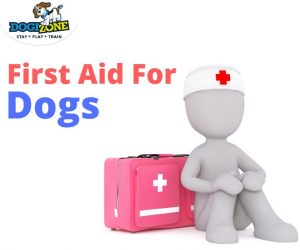First Aid for Dogs
 Dogs are a lot like children; they are always getting into things. Knowing a bit of first aid for dogs and having a dog-friendly first aid kit on hand is always a good idea. It is also worth having one in your vehicle and taking a small version in your backpack or hiking gear.
Dogs are a lot like children; they are always getting into things. Knowing a bit of first aid for dogs and having a dog-friendly first aid kit on hand is always a good idea. It is also worth having one in your vehicle and taking a small version in your backpack or hiking gear.
It is highly recommended to talk to your vet as he or she will typically sell or recommend a specific type of doggy first aid kit. They are relatively inexpensive, often less expensive that trying to make your own.
A Homemade First Aid Kit
If you do want to put together a kit on your own, you should consider:
- A durable metal or plastic “kit” that seals or has an airproof lid. Many of the commercially available kits are both dust and moisture proof.
- Bandages – consider a roll of vet wrap, which is a great top layer for protection. This is a tensor type of bandage that adheres to itself for easy application. You will also need a tensor bandage and several different sizes of absorbent gauze pads. Look for gauze in individual packages.
- Cotton balls and swabs – these can be placed in a zip lock bag to keep them fresh and free from moisture in the air.
- Tape – adhesive tape is very helpful to secure gauze in place.
- Blunt-end scissors – smaller scissors are fine but choose the blunt end style for ease of use without the risk of injuring the dog
- Small bottle of 3% hydrogen peroxide – used for wound cleaning and to induce vomiting for accidental poisoning.
- Medications – in an air-proof tube consider carrying a few Benadryl tablets for bug bites and allergic reactions as well as any medications your dog may be on. Talk to your doctor about having a pain medication on hand, do not use human medications unless under the direction of your vet.
- Tweezers
- Alcohol wipes – individually wrapped
- Antibiotic ointment – over-the-counter is a good option
- Styptic powder – used to stop bleeding
- Saline eye rinse – human eye solutions will work
Other helpful items will include disposable gloves, an ice pack, an oral syringe and a small flashlight. If you can, look for a small, travel size dog first aid book that can be a quick reference. Don’t rely on your phone as some remote areas may not have wireless service.
Take a Class
Having a kit is just the first step. Knowing what to do if your dog is bitten, cut or otherwise injured is difficult without specialized training. Many dog groups breed associations and even local community colleges or vets provide basic or advanced pet first aid training.
This training should include pet CPR, recognizing common health risks to pets and how to recognize and treat common issues like heat stroke, poisoning, cuts, broken bones and other types of emergency situations that can arise when you have a dog.

